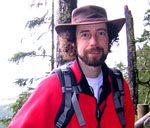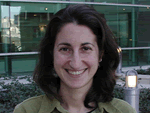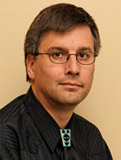 |
 |
| |
|
 |
Asa
Ben-Hur, Assistant Professor
Department of Computer Science, Colorado State University
Beh-Hur's
CV (pdf)
Title: A Kernel Method for
Predicting Protein-Protein Interactions
Abstract:
Most
proteins perform their function by interacting with other
proteins.
Therefore, information about the network of interactions that
occur in a cell can greatly increase our understanding of
protein function. We present a kernel method for predicting
protein-protein interactions using a combination of data sources,
including protein sequences, annotations of protein function,
local properties of the network, and interactions in different
species. We propose a pairwise kernel that provides a similarity
between pairs of proteins, and illustrate its effectiveness
in conjunction with a support vector machine classifier. We
obtain improved performance by combining several sequence-based
kernels and by further augmenting the pairwise sequence kernel
with features that are based on additional sources of data. |
 |
Larry
Hunter,
University of Colorado School of Medicine
http://compbio.uchsc.edu/hunter/ |
 |
Dr.
Kirk E. Jordan
(Bio)
Emerging Solutions Executive IBM Strategic Growth Business/Deep
Computing
Title: Blue Gene/L Impacting
Computational Biology - One Year Later
Authors: Kirk E. Jordan,
IBM Deep Computing
Abstract: Last year at Rocky ’04, I asked the
question is Blue Gene a System for Computational Biology?
One year has passed and Blue Gene has been placed at several
sites, many of which have a computational biology component.
In this talk, I will review some of the results obtained at
some of these sites. I will elaborate on work underway with
collaborators and colleagues in the area of computational
biology. For those unfamiliar with the Blue Gene System, I
will very briefly describe the hardware and software environment.
I will describe how Blue Gene might be used to tackle multi-scale
problems, many existing in computational biology. While progress
is being made, there remain many challenges for the computational
biology community to apply the Blue Gene resource to “Big”
science problems with impact on society that until now or
in current implementations have fallen short of the mark.
Finally, I will elaborate on opportunities that exist for
the community to get access to Blue Gene. |
 |
Dr.
Katherina J. Kechris
Postdoctoral Fellow
University of California, San Francisco
Department of Biochemistry and Biophysics
Kechris's CV (pdf)
Title: Sequence Analysis
of Human Alternative Splices Predicted from Exon Junction
Arrays
Abstract: Alternative splicing
of exons in a pre-mRNA transcript is an important mechanism
that contributes to the protein complexity found in humans.
Alternative splicing is thought to be regulated by various
protein-protein and protein-RNA interactions, including those
that involve specific sequence elements that act as enhancers
or suppressors. The recent adaptation of DNA microarray technology
to measure splice variants is providing new directions for
the high-throughput study of alternative splicing. In this
talk, methods will be presented for predicting alternatively
spliced exons from splicing arrays that consist of exon-junction
probes. I will then illustrate how contrast word counts and
regression-based methods can be used to identify candidate
enhancers and silencers that may regulate splice site choice. |
| |
Steve
Lincoln, Vice President of Informatics, Affymetrix,
Inc.
Title: Emerging Technology
and Applications of Affymetrix GeneChips: Implications for
Data Management and Analysis
Abstract: Over the last few
years, microarray technology has made significant contributions
to biomedical research and development by allowing high-quality
gene expression and genotyping data to be generated in volume
cost-effectively. Of the technology components needed to successfully
generate and exploit such data, arguably computational analysis
remains both critical today as well as a vital ongoing area
of research. With current evolution of microarray technology,
we believe this situation is soon to be amplified.
Using new manufacturing and instrumentation
technologies which scale down to 5 micron features, Affymetrix
GeneChip cartridges with over 6 million different probes,
as well as 96-well plates with 150 million probes, can be
reliably manufactured, hybridized and scanned. In this very
brief overview we will describe various new GeneChips which
have be designed using these methods and we will illustrate
biological data from these chips in a variety of applications:
gene expression, splice variant analysis, transcriptome analysis,
genetic variation and copy number analysis. We will also provide
a brief introduction to changes being implemented in instrumentation
and software to better accommodate the size and complexity
of these data. We will discuss data sets and other materials
available to the research community who may wish to pursue
any one of a number of open problems in the field. |
 |
Eugene
Myers, Ph.D.
Group Leader
Howard Hughes Medical Institute, Janelia Farms Research Campus
(HHMI JFRC)
http://www.eecs.berkeley.edu/~gene/
Title: Computer-Assisted Forensic Analysis
of Mass Disasters
Abstract: We examine the
problem of identifying remains in mass disasters such as the
World Trade Center, Waco, and airplane crashes. Typically,
the problem is closed or nearly so, in that the individuals
that could be involved are known. Depending on the state of
the remains, nuclear DNA profiles, typically the 13 CODIS
loci used by the FBI, are produced for each sample, and in
cases where the remains are significantly degraded, as in
the case of severe heat or fire, one may also sequence mitochondrial
DNA from the hyper-variable control region. The problem is
to determine the individual from whom each sample came from,
given the genetic profiles of near relatives and possibly
direct evidence from personal effects of the victim.
The talk will elaborate on the nature
of the data, develop the necessary background on computing
the probability of a pedigree, and formulate the overall goal
as a series of algorithmic problems with a preliminary progress
report on each. |
 |
Christoph
W. Sensen, Professor
University of Calgary, Department of Biochemistry and Molecular
Biology,
Sun Center of Excellence for Visual Genomics, Faculty of Medicine
http://www.visualgenomics.ca/sensencw
Title: Visualizing Bioinformatics
Results
Abstract: My laboratory has
long been involved in the creation of tools for the integration
and visualization of Bioinformatics results. Early efforts
focused on the characterization of Genomes, building tools
such as MAGPIE and Bluejay in the process. While we are still
working on tools for 2D Bioinformatics, we have embarked on
the visualization of data with a spatial and temporal aspect,
such as the results of Gene Expression or Protein modification
studies. Our approach is to build the computational infrastructure
for 4D Bioinformatics "top down". This includes the use of
Virtual Reality environments, the creation of a middleware
layer, which allows scientists to explore their data space
without scripting or programming, and the creation of "top
down" models of the organisms that we work with (mainly humans,
mice and rats). We are now beginning to conduct case studies
using the new environment, which are focused on the characterization
of genetic diseases and developmental patterns. |
|
|


